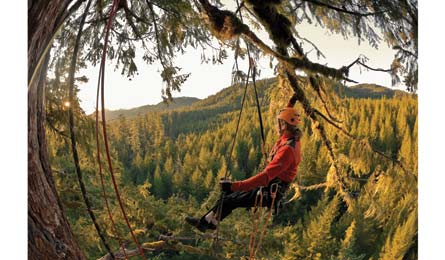Ultimate Adventure Handbook: Climb Big Trees

'Score views like this one. (David Collier)'
Learning curve: Go with a guide, the way most people start, and you simply need to be comfortable with heights. For DIY canopy exploration, you’ll need solid rope skills.
How
Suitable trees have trunks that measure at least six inches in diameter.
Look for candidates with the lowest branches no more than 35 feet off the ground (experts can double that). To lasso a branch, attach the rope to a throw bag and toss it over.
Use ascenders (single rope) or a series of pre-tied knots (double rope) to climb to the first branch. Repeat.
Conifers’ branches are more flexible than hardwoods; climb them at the trunk for greater security.
Use a rope sleeve to protect the bark and branches from rope burns ($25, newtribe.com).
Check the base; deep cavities weaken the tree and make climbing dangerous.
Climb slowly to conquer fear. “Go up 10 feet, pause for a while to acclimate, then climb another 10 feet,” says Patty Jenkins, co-owner of Tree Climbers International (TCI), an instructional school and climbers’ club.
Check restrictions: Tree-climbing is prohibited in national parks, but allowed on USDA Forest Service lands.
Watch Tree Climbing Basics ($20, treeclimbing.com).
Top spots
Georgia: Tree Climbers International hosts climbs ($20) and teaches classes ($475, treeclimbing.com) in Atlanta.
Oregon: In Willamette National Forest, the Pacific Tree Climbing Institute offers guided climbs of 300-foot-tall Douglas firs and hammock-supported, tree-top overnights (climbs start at $200).